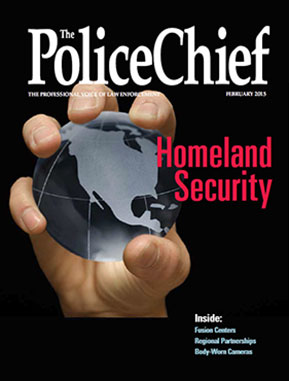
February 2015
Brandon Gardner/Guest Editor
The Office of Homeland Security came into existence 11 days after the infamous 9/11 terrorist attacks on the United States; since then, U.S. homeland security has garnered attention from U.S. leaders, including those in law enforcement. In recent years, there has been an increased emphasis on the role of collaboration in improving homeland security and the importance of state, local, and tribal agencies in these collaborative efforts.
Articles
-
Considering the Remote Use of Force via Unmanned Aerial Vehicles
Consider the following scenario: A man robs a liquor store at gunpoint, but as he flees he is confronted by an armed police unmanned aerial vehicle (UAV). He points his gun at the hovering aircraft... -
Leadership Consciousness in Policing
Tragedies have the potential to claim thousands of lives, injure thousands more, , and generally cause disruption. Large-scale events such as the plane attacks on the World Trade Center in New York, N... -
The Role and Efforts of the IACP Committee on Homeland Security
The International Association of Chiefs of Police (IACP) Committee on Homeland Security entered its current, final incarnation in 2003, although the committee arose out of the IACP’s response to 9/1... -
Impacting the Evolution of Information Sharing in the Post-9/11 United States
Information sharing among U.S. law enforcement agencies has evolved substantially since 9/11, including the sharing of crucial information among disciplines and jurisdictions through relationships tha... -
Fusion Centers: Enabling a Domestic Architecture for Sharing Information on a Range of Criminal Threats
The U.S. Homeland Security Act of 2002 defines a fusion center as a “collaborative effort of two or more agencies that provide resources, expertise, and information to the center with the goal of ma... -
Regional Partnerships: The Greater Boston Area’s Approach to Large-Scale Security
The U.S. Democratic National Convention (DNC) was scheduled to be held in Boston, Massachusetts, from July 26 to 29, 2004. It was the first time the national convention for either political party was ... -
Telling Stories: Preventing Violent Extremism Through Community Engagement
Radicalization to violence, wherever it occurs, is an emotionally charged issue. That means that any conversation about radicalization to violence is bound to be difficult, especially when initiated b... -
Connecting the Dots: Fusion Centers Working with Higher Education to Combat Terrorism
The U.S. criminal justice community and much of the U.S. public recall that the horrific events of 9/11 were preceded by several of the al Qaeda–affiliated attackers’ attendance at flight schools ... -
The 1033 Program: Effect on Law Enforcement and the Debate Surrounding It
The U.S. Department of Defense (DOD) Excess Property 1033 program has assisted law enforcement agencies for nearly 25 years. It is best known for its role in providing law enforcement agencies with cr... -
Police Body-Worn Cameras: An Overview
Forty-three years ago, Albert Reiss Jr., in his now classic book The Police and the Public, commented on the lack of official documentation on most police officer–citizen contacts. He suggest...
Columns
- President's Message: The Global Threat of Violent Extremists
- Chief's Counsel: Talking Themselves into Jail: First Amendment Rights and Retaliation Violations
- Legislative Alert: IACP President Richard Beary Testifies before President Obama’s Task Force on 21st Century Policing
- Commercial Vehicle Focus: Essential to a Successful “Challenge” Event
- February 2015 Line of Duty Deaths
- February 2015 Product Update
- February 2015 Products & Services
- Product Feature: Tactical Gear Balances New Designs with a Tradition of Craftsmanship
- Officer Safety Corner: Policing with Purpose: A Journey to Officer Wellness and Safety
- Research in Brief: Perceptions of Law Enforcement Officers in Seeking Mental Health Treatment
- February 2015 IACP Working For You

